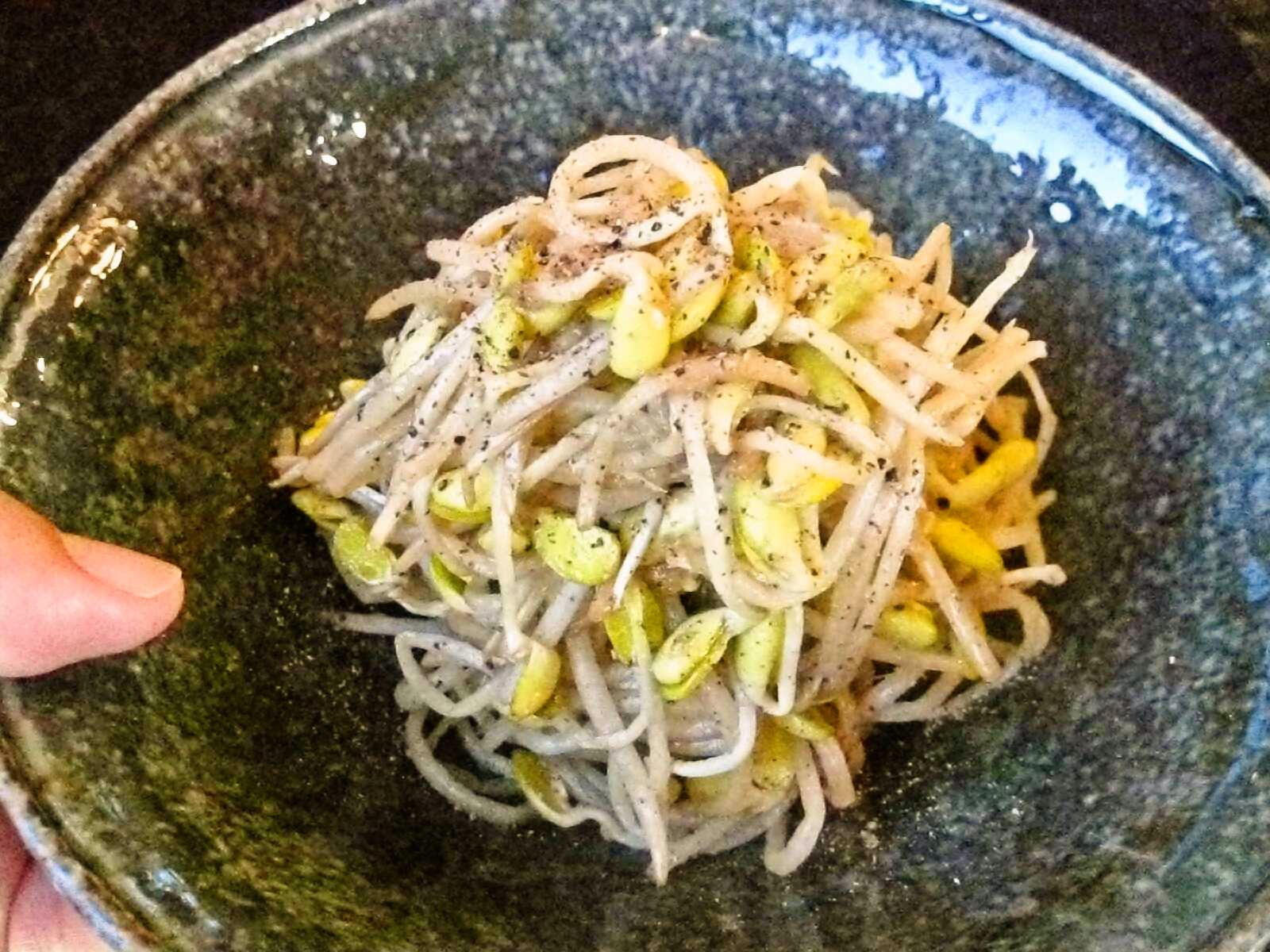All recipes are for 2 servings unless noted. Oil is canola oil and salt is kosher salt.
2013-06-30
Shiozake to piiman no amazubitashi / grilled salted salmon and green pepper marinated in sweetened rice vinegar
Grilled salmon is paired with juicy grilled green pepper and green onions. Dashi tones down the sweetened rice vinegar marinade and gives grilled ingredients a refreshing, light taste.
Labels:
2 easy,
30 min,
bento,
fish,
green onions,
green peppers,
grill,
make ahead,
marinate,
party,
picnic,
potluck,
Recipes - Japanese,
salmon,
seafood,
shiozake,
vegetables
2013-06-28
Konsai no yooguruto misoshiru / root vegetable miso soup with yogurt
A tasty miso soup without dashi! Miso and yogurt, both fermented food, go hand in hand to make a flavorful broth with lingering umami. Here is an example with daikon radish, gobo burdock root and carrot.
Labels:
1 very easy,
10 min,
carrots,
daikon,
gobo,
Recipes - Japanese,
simmer,
soup,
yogurt
2013-06-26
Mibuna no asazuke / salt-pickled mibuna mustard greens
Mibuna has a tingling spicy taste, which is especially clear when pickled with salt. Taka no tsume red chili slices add an extra jolt, while thinly sliced kombu kelp brings a mellow note that softens the overall taste.
Labels:
1 very easy,
10 min,
bento,
make ahead,
mibuna,
no cook,
pickles,
Recipes - Japanese,
vegetables
2013-06-22
Ingen no umeni / green beans simmered with pickled plum
A simple green bean dish with a fruity note. The soft acidity of umeboshi pickled plum makes this a delightful dish for warm or hot days. Niboshi dashi made of dried young sardines gives a punch to the underlying taste.
Labels:
1 very easy,
10 min,
30 min,
green beans,
ingen,
Recipes - Japanese,
simmer,
umeboshi,
vegetables
2013-06-21
Mizuna no jako sarada / mizuna salad with crispy young dried sardines
Crispy jako sauteed in sesame oil is added to edgy citrus-flavored soy sauce softened by dashi, resulting in a rich yet refreshing dressing for fresh mizuna.
Labels:
1 very easy,
10 min,
chirimen jako,
mizuna,
Recipes - Japanese,
salad,
toast,
vegetables
2013-06-18
Sakana no sotee, ume-shiso soosu / fish saute with plum-perilla sauce
Softly sour and refreshing umeboshi pickled plum sauce with shiso perilla leaves is a popular choice when the weather turns warm. It brightens the heavy taste of oil used in cooking while stimulating your appetite at those times you do not feel like eating because of heat or fatigue.
Labels:
1 very easy,
30 min,
fish,
Recipes - Japanese,
saute,
seafood,
shiso,
umeboshi
2013-06-14
Atsuage to chingensai no kurozuan itame / deep-fried tofu and baby bok choy saute with thickened brown rice vinegar sauce
Kurozuan sauce, a variation of thickened sauce based on amazu sweetened rice vinegar, is made with kurozu brown rice vinegar. It has a rich aroma while offering a refreshing note, making this simple saute satisfying yet light.
Labels:
10 min,
2 easy,
atsuage,
chingensai,
kurozu,
Recipes - Japanese,
saute,
stir-fry
2013-06-12
2013-06-09
Hoshi-kaibashira to hakusai no misoshiru / miso soup with dried scallops and napa cabbage
More commonly used in Chinese dishes, dried scallops help create an aromatic dashi for miso soup. Hakusai napa cabbage, an excellent match for dried scallops, gives a mellow sweet note to the soup, while the petite tomatoes add vivid color and a sour punch.
2013-06-07
Tom cooks 13. Chaahan (fried rice with assorted ingredients)
Fried rice is a creation to finish up leftover rice from previous meals. We freeze leftover steamed rice, and when enough has accumulated, it turns into fried rice. It is one of Tom’s menu choices to feed me when I am swamped with work.
 He proves how nice he is by cooking my favorite food. He can also shut out my potential complaints on his food (Tom sees my comments as complaints). Fried rice à la Tom serves more than two purposes. A value meal?
He proves how nice he is by cooking my favorite food. He can also shut out my potential complaints on his food (Tom sees my comments as complaints). Fried rice à la Tom serves more than two purposes. A value meal?
 He proves how nice he is by cooking my favorite food. He can also shut out my potential complaints on his food (Tom sees my comments as complaints). Fried rice à la Tom serves more than two purposes. A value meal?
He proves how nice he is by cooking my favorite food. He can also shut out my potential complaints on his food (Tom sees my comments as complaints). Fried rice à la Tom serves more than two purposes. A value meal?2013-06-04
Daizu moyashi no misoshiru / miso soup with soybean sprouts
Daizu moyashi become somewhat sweet from sauteing and simmering while covered. Sauteing with sesame oil adds a soft rich taste, which is countered by a sprinkle of straightforwardly spicy ichimi chili pepper at the very end.
Labels:
10 min,
2 easy,
bean sprouts,
daizu moyashi,
ichimi,
miso,
moyashi,
Recipes - Japanese,
soup,
soybean sprouts
2013-06-03
Niboshi dashi / dried young sardine stock
For many families, dashi made with niboshi dried young sardines is essential for their everyday miso soup. Niboshi give a deep flavor and gentle punch to the stock. There are two main ways of preparing niboshi dashi. One is to remove the sardines’ heads and bellies, toast on low heat and then simmer for some time. The other is to soak whole niboshi in cold water overnight. The latter method results in a lighter taste. Outlined below is the “toast and simmer” version.
Labels:
1 very easy,
30 min,
dashi,
Ingredient preparation,
niboshi,
Recipes - Japanese
2013-06-01
Ingen to satsumaage no nimono / green beans and deep-fried fishcakes simmered in broth
The “green” taste of ingen green beans is highlighted by the soft, somewhat sweet taste of satsumaage. This is on the strong end of flavor, and a small amount makes a satisfying companion for rice or drinks.
Labels:
10 min,
2 easy,
bento,
fishcake,
green beans,
Recipes - Japanese,
satsumaage,
simmer,
vegetables
Subscribe to:
Posts (Atom)











